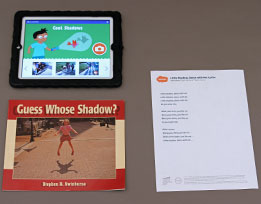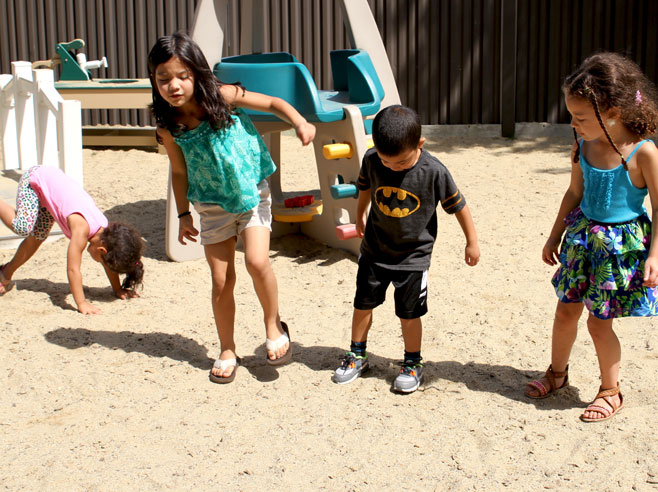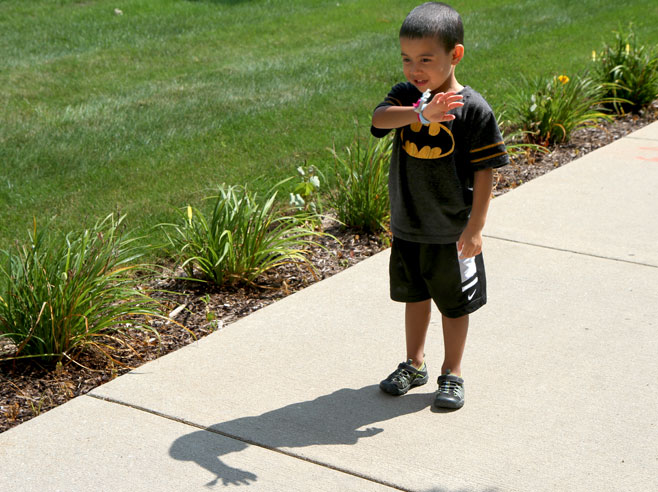Children move, sing and dance, and watch their shadows do the same. They document their shadows with the Cool Shadows tool.
Materials

- Cool Shadows tool in the digital Shadows Journal on the iPads (1 iPad for each adult)
- Guess Whose Shadow? by Stephen R. Swinburne
- Optional: Little Shadow, Dance with Me: Lyrics (PDF)
Preparation
- Visit your outdoor play area or another safe outdoor location at different times of day to preview the shadows that can be seen and determine where children can best see their own shadows. If your school has a lot of surrounding buildings, note when the sun is most visible in order to create the clearest shadows.
- Familiarize yourself with the words to the song “Little Shadow, Dance with Me” (sung to the tune of “Skip to My Lou”). If you wish, print out the words on the Little Shadow, Dance with Me: Lyrics PDF.
- SAFETY ALERT: Each time you go outside, remind children never to look at the sun because it can harm their eyes.
Directions: Lesson 1
Outdoors
You may want each classroom adult to have an iPad so Cool Shadows entries are recorded on more than one device. Over the course of Week 1, each child should create at least one Cool Shadows entry.
- Bring the book Guess Whose Shadow? to an outside play area with the class. Try to go in the early morning or late afternoon, when shadows are the longest and most dramatic.
- Engage children in shadow play and help them observe and describe their shadows:
- Let’s see if we can find our shadows. Wave to your shadow!
- Can you tell which shadow is yours? How do you know?
- Let’s compare ourselves and our shadows. What is the same about you and your shadow? What is different about you and your shadow?
- Look at the shadow of your head. Can you see any eyes in your shadow? Can you tell what color your hair is by looking at your shadow?
- Why do you think there are shadows today? Where is the light coming from? Remind children not to look directly at the sun. Now point to your shadow. Why does your shadow appear on that side of your body? (The sunlight shines all around you, but the sunlight cannot shine through your body. Your shadow is the dark area where the light has been blocked.)
- Invite children to explore shadow shapes they can make by posing their bodies in different ways.
- Say, When you make a really interesting shadow, let me know and I can take a picture. They might recreate a shadow from the “Little Shadow, Dance with Me” song or the Guess Whose Shadow? book or create a new shadow shape.
- Enlist the help of children as photographers!
- As a group, revisit the gallery of photos children have taken and encourage them to discuss the shadow photos. Possible discussion ideas:
- Tell me about this shadow. Whose shadow is this? How did you make this shadow? What do you notice about this shadow? What makes it interesting?
- In the book Guess Whose Shadow?, show the photo of the boy standing on a red, blue, and yellow number grid. Remind children of the shadow game he is playing. The boy is making the shadow of his head touch the number 8. Let’s find something that you can make the shadow of your head touch. Help children identify nearby objects and invite them to move so the shadow of their head touches those objects. You may want to document this activity by taking photos with the Cool Shadows tool.
The photos taken during this activity will be shared and discussed as a class during the Circle Time: Wrap-Up Cool Shadows Review activity.


